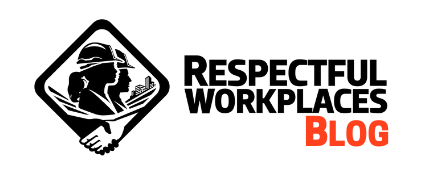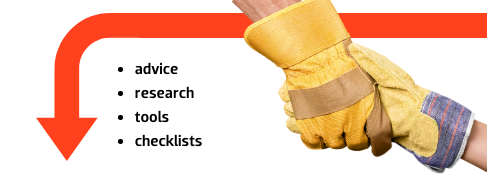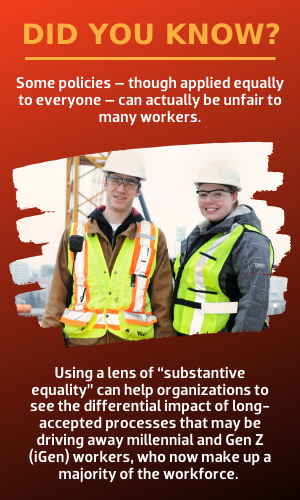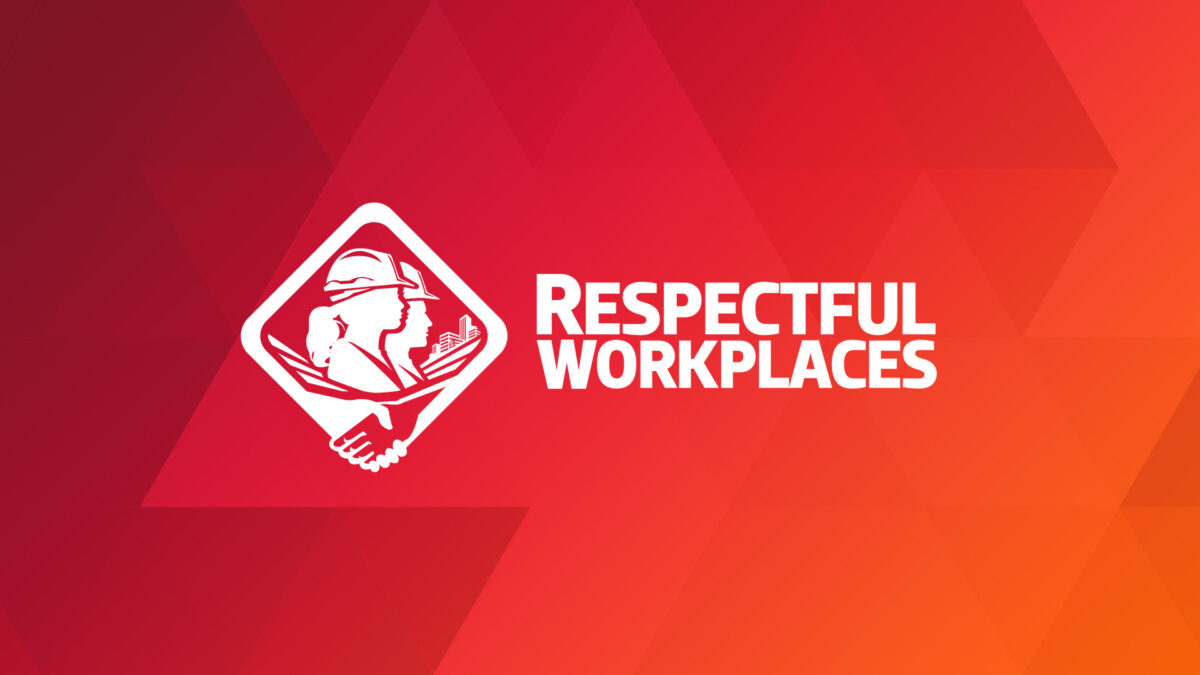

The Canadian construction industry is building respectful and inclusive workplaces for a strong future
Does your organization use the lens of “substantive equality” to foster respect and inclusion?

Research shows that creating and sustaining a respectful and inclusive workplace has many benefits beyond just meeting legal requirements. Respectful and inclusive workplaces create workplaces that welcome people of different genders, backgrounds, and circumstances, and this brings more innovation and higher financial returns.
These workplaces also have greater ability to recruit and retain millennial and Gen Z (iGen) workers, who now make up a majority of the workforce. Feeling appreciated and liking their workplace culture are key factors in retaining these younger workers. In addition, younger workers rate organizations that actively recruit and retain people with different genders, backgrounds, and circumstances more highly than those that don’t. All of these factors make it desirable for organizations to recruit and retain younger workers, and those of different genders, backgrounds, and circumstances.
Yet often, seeing the obstacles to recruiting and retaining workers from these applicant pools can be difficult.
Using a lens of “substantive equality” can help organizations to see the differential impact of long-accepted processes that may be driving away these workers.
For example, researchers have found that women working in construction and other technology-based industries face barriers that are invisible. Systems of recruitment and promotion that treat everyone the same, or equally, often have a differential impact on women that is usually disadvantageous.
If organizations rely on word of mouth for recruitment and promotion, women are at a disadvantage because they tend to have fewer internal company contacts and, as a result, are less likely to be recommended for job openings and promotions.
Another area where processes that seem to treat everyone equally but result in unequal outcomes is the selection of candidates. Research shows that when reviewing identical resumes, both men and women prefer to choose a candidate with a male name over one with a female name by a ratio of two to one.
So it is not ability, or even overt discrimination, that prevents women from being recruited or promoted; it is a culmination of processes that are unintentionally biased that result in discrimination against them.
Discrimination laws seek to address this by striving for “substantive equality.” Human rights laws recognize that overt acts, behaviours or decisions that discriminate can be intentional. However, intention is not necessary in order to determine if discrimination exists: it is the outcome that matters. Processes and programs must result in fair workplace conditions, or “substantive equality” for all workers.
Because discrimination can be invisible to the majority of people, and is often embedded in workplace culture, “this is the way we’ve always done things,” eliminating it requires an organization-wide commitment to re-thinking many of its processes and programs and their unintentional results.
For example, in light of COVID-19, our industry is re-thinking the way it has always done things in terms of site health and hygiene. Site toilet cleanliness and hand washing may have once been considered the concerns of the overly fastidious, or unimportant compared to the pressing issues of deadlines and project costs, but COVID-19 makes this attitude outdated.
COVID-19 serves to underscore the benefits of respectful and inclusive principles as proactive. Organizations that are committed to respect and inclusion for all workers may already have considered the need to give more attention and resources to site toilet cleanliness and hand washing. Research shows that younger workers have different expectations than older generations, and these workplace conditions have an impact on the ability to recruit and retain younger workers. Employers ignore these changing attitudes at their peril.
As COVID-19 causes organizations to assess processes around site toilet cleanliness and hand washing, they should also be thinking about substantive equality as a measure of their commitment to a respectful and inclusive workplace.
In light of substantive equality, certain practices regarding access to site toilets and hand washing could be deemed as discriminatory. On some sites, men and women are required to use the same toilet in the belief that this is equal treatment. In reality, women have a different washroom experience than men, and the effect on women is not equal. So even though men and women are being treated the same or equally, there is a differential impact on women. The failure of an organization to understand and support substantive equality undermines its claims as a respectful and inclusive workplace.
These types of considerations make a large statement about an organization’s commitment to respect and inclusion. Viewing processes and programs through the lens of “substantive equality” is a forward-thinking approach that can help organizations to recruit and retain younger workers and people of different genders, backgrounds, and circumstances. It helps to position an organization as proactive in addressing the realities of a modern workforce and gain a competitive advantage.
The BuildForce Respectful and Inclusive Workplace Toolkit provides the resources needed to help organizations create a competitive advantage through a respectful and inclusive workplace. The Respectful Workplace Online Self-Assessment Tool may be of particular interest to those organizations that want to be more proactive in fostering a respectful and inclusive workplace.
For more info:
- Deloitte. “2018 Deloitte Millennial Survey”. See https://www2.deloitte.com/content/dam/Deloitte/global/Documents/About-Deloitte/gx-2018-millennial-survey-report.pdf.
- Deloitte. “The Deloitte Global Millennial Survey 2019”. See https://www2.deloitte.com/global/en/pages/about-deloitte/articles/millennialsurvey.html.
- McKinsey. “Why Diversity Matters”. January 2015. See https://www.mckinsey.com/business-functions/organization/our-insights/why-diversity-matters.
- Steinpreis, Rhea E., Anders, Katie A., Ritzke, Dawn. “The Impact of Gender on the Review of the Curricula Vitae of Job Applicants and Tenure Candidates: A National Empirical Study”. (1999). Sex Roles, Vol. 41, Nos. 7/8.
Read from the beginning. Click here to start at Part 1.
What can an effective Respectful and Inclusive Workplace Program deliver?
- Become an employer of choice – attract, retain, and advance top talent from all sources of labour
- Unlock collaboration and innovation – create high-performing teams through diversity of thought and experience
- Build your brand – your organization will gain a competitive edge as a leader and innovator
Get started today!
The BuildForce Canada Online Respectful and Inclusive Workplace Toolkit includes:
- the Respectful Workplace Online Self-Assessment Tool to assist organization leadership in assessing their current situation and identifying where they may need to make changes
- the Respectful Workplace Policy Framework and Implementation Guide to assist organizations in creating and implementing a policy that supports a respectful and inclusive workplace
- the Respectful Workplace Online Training Course to train workers on how to create and support a respectful and inclusive workplace
- the online course Introduction to Understanding Systemic Racism: A Guide for Leaders and Managers
All the resources you need to create and support a respectful and inclusive workplace!

Respectful and Inclusive Workplaces
